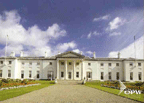Dublin’s Phoenix Park: Ireland’s historical heritage

Dublin’s Phoenix Park, Ireland, Fallow Deer, Ita Marquet
Dublin’s Phoenix Park is located 2.5 km west of Dublin City. With a boundary stone wall of 11 km and 22 km of roads, at 707 hectares the park is one of the largest enclosed recreational and leisure spaces within any European capital city. It has been managed as a National Historical Park since its designation in 1986 a year after the Council of Europe Convention for the protection of the Architectural Heritage was adopted by the European Council of Ministers, Ireland being one of its signatories.
A herd of Fallow Deer has lived in the park since 1662 since their introduction by the illustrious viceroy Duke of Ormonde. At its largest the herd numbered almost 1300. During the ‘Emergency’ (World War II), the herd was reduced to only forty. Today the herd is maintained at about 450 with four colours, black, brown, common and menil.
Phoenix Park is a sanctuary for many mammals including foxes, badgers, rabbits etc. Over forty species of birds have been recorded in the park. Research studies and surveys are ongoing and include studies on mammals, invertebrates, aquatics and nocturnal species. A wide range of wild life habitats are to be found in the park, areas of which are managed as conservation heritage.
Conservation and management of the park is guided by the Florence Charter on historic gardens as set out by the International Council on Monuments and Sites (ICOMOS). The many monuments and other historical buildings within the park reflect Ireland’s historical heritage. A contemporary feature is the simple large Papal cross that was erected for the Papal visit of Pope John Paul II in 1979 on his celebrated visit to Dublin’s Phoenix Park.
Ireland’s historical heritage
A list of significant dates start from 1177 when Hugh Tyrell, first Baron of Castleknock, granted land including what is now Phoenix Park land to the Knights of St. John of Jerusalem at Kilmainham. In 1537 Henry VIII confiscated the lands and in 1617 lands were surrendered to the crown to be used by the King’s representative in Ireland. Having considerably improved the park, Lord Chesterfield opened Phoenix Park to the public in 1747.
In the reign of King Charles II, James Butler, 12th Earl of Ormonde, was appointed Lord Lieutenant of Ireland in July 1662. Development of a deer park was considered on lands attached to Phoenix House … “the abode of the King’s representative in Ireland”. The land initially included the original demesne of Kilmainham Priory south of the River Liffey. While Ireland’s own Royal Park commenced in the 17th century, its present landscape and infrastructure is inherited from designs and managerial decisions which were taken from 1800 to 1880. The Victorian People’s Flower Garden was designed during this period and was noted for its novel experimentation with floral displays.
West of St. Mary’s Hospital, formerly the Hibernian Military School dating from 1766, stands a prehistoric burial chamber over 5,500 years old. The tumulus which covered it was opened in 1838 and skeletons, pottery and other relics, now in the National Museum were discovered. A similar sepulchre found in a gravel pit at Chapelizod was re-erected in the Zoological Gardens. Dublin Zoo was opened in 1831; it is a popular and much visited feature of the park.
Built in 1751, the large Park Ranger’s house was formerly the official residence of the British viceroys in Ireland from 1782 to 1922. After the Act of Union formed the United Kingdom of Great Britain and Ireland in 1801, the house was extended and embellished to reflect its increased ceremonial importance and became the centre for fashionable society. The original house was later demolished.
Built in 1774 as the Bailiff’s Lodge, then the Chief Secretary’s Lodge, in 1929 Deerpark became the official residence of the United States Ambassador to Ireland, that had established a legation to the Irish Free State in 1922. The Ambassador’s residence was originally in the ancient Ashtown Castle within Phoenix Park.
The Residence of the President tells a fascinating story about Ireland. Set in 130 acres of parkland and gardens it replaced the construction of the original house in 1751. On one of her three visits, Queen Victoria planted the Wellingtonia on the lawn. The last monarch to visit was her grandson, George V, in 1911.
Irish independence came a decade later but the royal link continued: the house became the residence of the Governor General, an office set up under the Anglo-Irish Treaty. In later years the Governor General no longer lived there and the house was effectively abandoned until major refurbishments were carried out by the State Office of Public Works in the 1940s and 1950s with the house, gardens and ancillary buildings still being developed.
The Residence of the President of Ireland, Aras an Uachtarain, mirrors the history of Ireland from the 18th century to the present. It is both a family home and a venue for formal State occasions where the President carries out many official duties. The house was opened to the public in 1998. It includes visits to the formal gardens with many Victorian features leading to the Queen’s Walk flanked on either side by ceremonial trees and into the upper walled garden bounded on the south by a Turner peach house.
Visitors received over the years have been Pope John Paul II, Prince Charles, Kofi Annan, Nelson Mandela, President Bill Clinton, President John F. Kennedy, Senator Hillary Clinton, President Charles de Gaul, President Freiberga of Latvia and many of the world’s contemporary leaders. It reflects the transition to the Ireland of today - a modern democracy in a modern Europe - that is part of Ireland’s historical heritage.
Ita Marguet, September 2009
Note: Acknowledgement is given to sources used in preparation of this text. It follows a visit by the author to Dublin’s Phoenix Park in May 2009.


